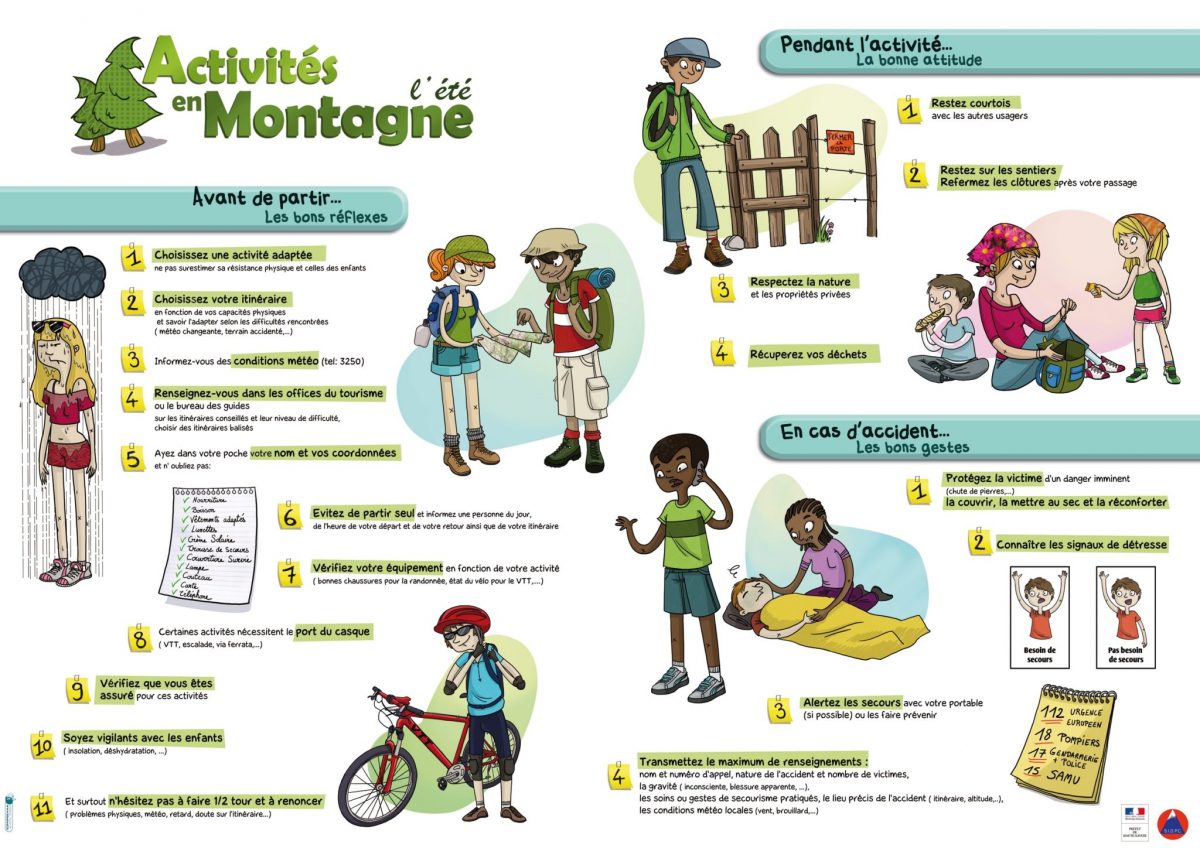Your safety in the mountains
To ensure your safety in mountainous terrain, you must be fully aware of the environment and the conditions. To ensure this, we are going to share some information with you, about:
- The weather
- Walking in the mountains
- What to do in the event of an accident

The weather
How to find out more
Météo France: +33 (0)8.36.68.02.74
Bad weather can be anticipated with the arrival of a low (barometre showing less than 800mbar). The quicker this happens, the shorter the period of bad weather, and vice versa. Bad weather is not always necessarily dangerous (except for storms), but the consequences could be disastrous:
- Rise of water levels in the rivers, preventing a retreat
- Slippery slopes
- Falling rocks and gully erosion
- Fog or a lack of visibility
- A quick drop in temperatures
It is therefore advisable to avoid going out during bad weather and at worst, heading to the nearest safe shelter. Even though weather forecasts are becoming more and more reliable, it is not always possible to access this information when you are trekking. Therefore, you must be prepared for a change in weather conditions.
The signs and characteristics of bad weather to come
- The absence of morning dew
- An increase in altitude on the altimeter (for one same given point, a difference between the morning and evening for example)
- A red sky as the sun rises (a very red sunset is sign of good weather)
- Clouds forming around the peaks
- Aggressive insects, people becoming bad-tempered, birds flying low
- Far-away peaks seem closer and more visible (humidity acts as a magnifying glass: hygrometry phenomenon)
- Marks left in the sky from planes stay for longer than usual (the humidity in the air produces condensation behind the jet engines)
The clouds
There are three main categories of clouds, depending on altitude
1- An altitude of between 6,000 and 1,000 metres: CIRRUS
- Cirrus: thin, wispy strands, they are made up of ice crystals
- Cirrocumulus: like little tufts of clouds
- Cirrostratus: form halos, a veil
If you see one of these three types of clouds, it is a sign that a low is coming in the next 4 to 24 hours
2- An altitude of between 2,000 and 6,000 metres: ALTO
- Alto: globular masses
- Altostratus: a grey uniform layer without halo
- Cumulus: fluffy clouds, they could be a sign of good weather to come, or transform into:
- Cumulonimbus (formed by powerful upward air currents) at an altitude of between 800 and 12,000 metres. Dark at the base, this dense, towering vertical cloud means that there is a risk of a storm.
3- An altitude of between 100 and 2,000 metres: STRATUS
- Stratus: dense, low-level clouds, rain clouds
- Nimbostratus: these clouds bring rain or snow
What to do in the event of a storm
- Leave the peaks and head for lower altitudes
- Do not take shelter under a rock, it is better to stay on the snow, on your bag.
If you can see a storm approaching from afar, watch how it evolves and which direction it is moving in. If it is headed your way, go down to lower altitudes and of course, don’t panic (you don’t want to twist an ankle, or worse), head towards the bottom of the valley or a shelter (farm, refuge). Be careful, you are not free from the risk of lightning in the valley, even though it is more likely to strike the peaks and summits.
There is a strong risk of lightning if your hair starts to stand on end, if you can hear a buzzing sound, if bluish sparks appear on your metal equipment (ice pick, studs). In this case, you must leave the area immediately.
Walking in the mountains
Some rules to adhere to
- Don’t set off alone
- Inform someone of your whereabouts
- Leave early and come back early
- Make sure you know your itinerary
- In case of any doubt whatsoever, stop by the local guides office and ask a professional for assistance
- Look at the weather forecast
- Don’t hesitate to change your plans
- Do not rely on your mobile telephone for assistance: many people venture beyond the boundaries of possible communication with emergency services. This is strictly forbidden!!
OBJECTIVE DANGERS: NATURAL PHENOMENA
- Grassy slopes (they are just as slippy as snow, avoid them at all costs, especially if the ground is wet)
- Snow patches (risk of slipping, collapse of a snow bridge. There’s no use bringing an ice pick if you don’t know how to use it. It would be better to have two telescopic poles. Don’t hesitate to turn back, especially if the snow patches are on sloping terrain across rocks or a cliff side. Otherwise, use a handrail).
- Slopes (avalanches of stones or snow in winter, terrain is often crumbly and unstable)
- Cliff ledges (don’t go near them!!!)
- Nightfall (if you are not prepared this can be extremely dangerous, always take a headlamp and warm clothing with you).
- Sun (risk of sunstroke, sunburn and ophthalmitis. Always take an extra pair of sunglasses, a hat or cap and sunscreen).
- Water (risk of germs, use water disinfectants such as hydroclonazone or micropur, available to buy from a pharmacy in France).
- Toxic plants: Monkshood, colchium, deadly nightshade, foxglove, lily of the valley (that’s all very well but you need to be able to recognise these plants. Just don’t put anything in your mouth!!).
SUBJECTIVE DANGERS
- Inadequate preparation
- Lack of knowledge of the area
- Lack of technical skills
- Lack of training
- Lack of experience at high altitudes
- Inaccurate appraisal of the difficulties
- Overestimation of your abilities or those of the group
- Unsuitable equipment
- Exhaustion, fatigue, a fall
- Recklessness, wanting to push your limits
What to do in the event of an accident
For serious accidents
- Protect the injured party, move him/her away from any further risk
- Check for bleeding and if there is any, apply pressure or a compression bandage
- Has the injured party lost consciousness? If so, put him/her on their side
- Is the injured party still breathing? If not, provide artificial respiration
- Is the injured party in cardiac arrest? If so, perform CPR and artifical respiration
For minor injuries
- The victim is feeling unwell or dizzy: ensure they stop to rest
- The victim has a burn: douse in cold water and then wrap a bandage around the wound
- The victim has an open wound: lie them down and rest the wounded part of the body
CONTACTING EMERGENCY SERVICES:
- You must get to a communication point as quickly as possible (be careful, the person going for help needs to make it back…, avoid causing a second accident).
- Call 18 for the fire service/paramedics, 15 if you require medical assistance for serious injuries, or dial 112 from a mobile telephone.
- You will need to provide the exact location of the injured party: town, mountain, slope, altitude.
- You will need to provide information about the condition of the injured party. All this information needs to be clear in your mind before calling emergency services. Therefore, you always need to know exactly where you are on the mountain.
You’ve probably understood by now, to avoid these situations you need to be careful. There are so many wonderful things to see and do on this earth without taking risks, you just need to know where to look……
This advice was given by ArnoRetrif

